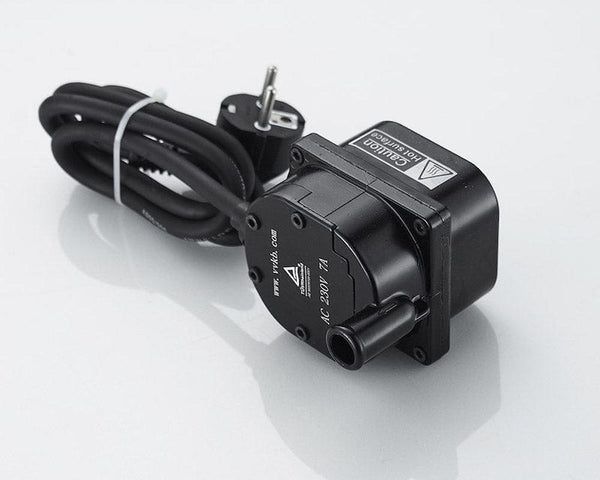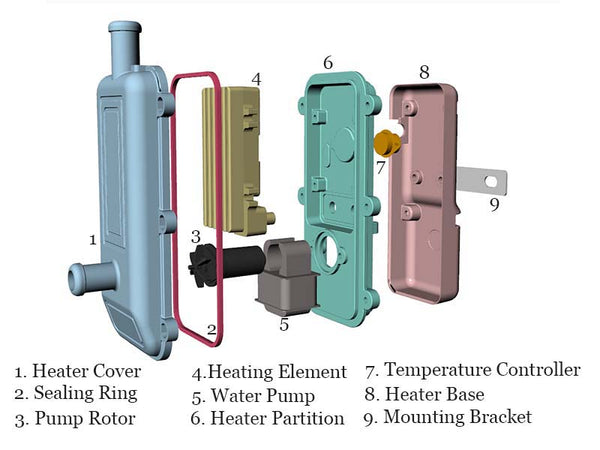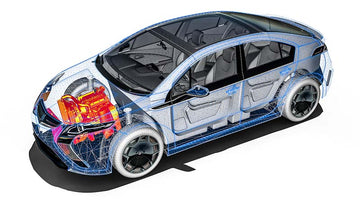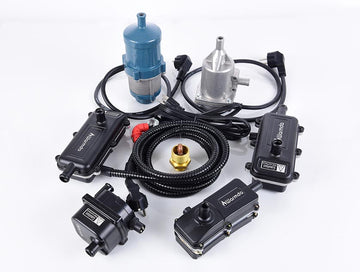Experience the Difference: Selecting the Ideal Engine Heater for Your Vehicle
Feb 29, 2024
Introduction
In colder regions, the challenges faced by vehicles far exceed what most people imagine. Low temperatures not only make starting the vehicle more difficult but can also have long-term negative effects on the engine's life and performance. This is precisely why engine heaters become indispensable equipment in cold weather, especially for those living under extreme climatic conditions.

The Impact of Cold Regions on Vehicles
Under low temperatures, engine oil becomes much thicker, significantly increasing friction during engine startup. Thermal expansion and contraction can cause gaps between engine components to widen, leading to poor cylinder sealing and difficulty starting in winter. Prolonged exposure to these conditions not only increases fuel consumption but may also cause premature wear of engine parts, shortening the engine's overall lifespan. Moreover, cold weather can degrade battery performance, affecting vehicle reliability and safety.
The Importance of Engine Heaters
Engine block heaters work by heating the coolant in the engine's cooling system, transferring the heat to the engine block. This pre-heats the engine oil and the engine itself, reducing wear and friction during cold starts. By maintaining optimal operating temperatures, engine heaters not only extend engine life but also improve fuel efficiency and reduce emissions. On cold mornings, they ensure vehicles start quickly and reliably, offering great convenience and peace of mind to drivers.
Features of Vvkb Engine Heaters
With 28 years of experience in manufacturing block heaters, Vvkb stands out in the market for its exceptional performance, reliability, and customer service. These heaters employ advanced heating technology to quickly bring the engine to the ideal working temperature, ensuring smooth starts even in the harshest conditions. Vvkb engine heaters are designed for ease of use and installation, ensuring vehicle owners can easily set up and operate them. Moreover, their energy efficiency helps save significant fuel and maintenance costs over time.

Supported by real-world cases and customer testimonials, Vvkb engine heaters have proven their ability to enhance user experience and solve vehicle startup problems in cold weather. Many owners have shared their experiences of easier starts and improved overall vehicle performance after installing Vvkb heaters.
When considering the long-term performance and safety of your vehicle, choosing a high-quality engine heater is crucial. Vvkb engine heaters, with their efficient heating capabilities, ease of installation, and minimal environmental impact, are the top choice for owners in cold regions. They not only offer extra protection for your vehicle but also bring a revolutionary change to your driving experience.
Why Choose an Engine Block Heater
Maintaining optimal vehicle performance in cold climates is a significant challenge for every vehicle owner. As an effective solution, the importance and benefits of engine heaters cannot be overlooked. Understanding how engine heaters work and the advantages they bring, as well as the risks of not using one, is vital for making informed decisions.
How Engine Block Heaters Work
Engine Block heaters reduce friction and wear during cold starts by pre-heating the engine and engine oil. They can directly transfer heat to the engine's cooling system through electric heating elements. This pre-heating process ensures the engine is close to its normal operating temperature at startup, reducing the extra friction caused by increased oil viscosity.

Benefits of Engine Block Heaters in Cold Weather
- Reduced Wear: By lowering friction during cold starts, engine heaters significantly reduce wear on internal engine parts, extending the engine's life.
- Improved Fuel Efficiency: Pre-heating the engine helps reach effective combustion temperatures faster, reducing fuel consumption and emissions.
- Enhanced Reliability: Ensures reliable vehicle startups in extreme cold, avoiding many weather-related issues.
- Increased Comfort: Engine pre-heating also speeds up the work of the vehicle's heating system, providing warmth to drivers and passengers more quickly in cold weather.
Potential Risks of Not Using Heaters
Vehicles without engine heaters may face several issues when starting in cold environments:
- Increased Wear and Damage: Cold starts are one of the most severe moments of engine wear. Frequent cold starts accelerate engine wear, reducing its lifespan.
- Lower Fuel Efficiency: Engines that are not pre-heated take longer to reach optimal working temperatures, consuming more fuel in the process.
- Reliability Issues: In extremely low temperatures, thick oil and decreased battery performance can make it difficult for the vehicle to start, affecting its reliability.
- Decreased Comfort: It takes longer for the vehicle's heating to warm up, affecting passenger comfort.
- Environmental Harm: Cold starts increase engine exhaust emissions significantly, contributing to environmental damage.
By incorporating specific customer testimonials, we can see how Vvkb engine heaters address these issues in practice. For instance, a vehicle owner from Montreal, Canada, shared his experience of using a Vvkb heater. Before installation, he often faced anxiety over difficult starts and significant engine wear. After installation, not only did his vehicle start smoothly every time, but fuel efficiency also improved, significantly enhancing his overall driving experience.
Vvkb engine heaters, with their efficient heating performance and easy installation, tackle the challenges cold weather poses to vehicle performance and reliability. Choosing Vvkb means investing in your vehicle's performance, enhancing driving and riding comfort, and ensuring confidence and peace of mind with every journey.
Identifying Your Needs: Selecting the Right Engine Heater
When choosing the most suitable engine heater, understanding the different types of heaters and how to select one based on your vehicle type and usage environment is crucial. Additionally, a wise choice will maintain your vehicle's performance in winter, avoiding potential issues and enhancing your driving experience.
Overview of Different Types of Engine Heaters
There are various engine heaters on the market, each with its unique working principle, advantages, and disadvantages. Here are some common types of engine heaters and their features:
Engine Block Heaters
- Working Principle: Connected to the engine's cooling system, these heaters use heating elements to warm the engine coolant. An internal pump circulates the heated coolant throughout the engine, significantly reducing the heater's operation time and improving efficiency.
- Advantages: Easy to install, reliable operation with built-in temperature controllers, very safe.
- Disadvantages: Requires an external power source, not suitable for environments without parking power.

Diesel Engine Heaters (and Gasoline Engine Heaters)
- Working Principle: Similar to engine block heaters, they are installed within the engine's cooling system. By burning gasoline or diesel, they heat the engine coolant, making it easier for the engine to start.
- Advantages: Convenient to use, only requiring the vehicle's battery power. Utilizes the vehicle's fuel, greatly facilitating usage. After using diesel or gasoline engine heaters, one can enjoy a warm cabin environment.
- Disadvantages: Relatively expensive, with higher installation and maintenance costs, requiring regular checks.

Oil Pan Heaters
- Working Principle: Electric heating elements attached to the oil pan by adhesive or screws heat the engine oil, reducing its viscosity.
- Advantages: Directly heats the oil, quickly increasing oil temperature, improving startup performance.
- Disadvantages: Heating effect greatly influenced by external temperatures, also requires an external power source.
Coolant Heaters
- Working Principle: Heat the coolant to indirectly raise engine temperature. Some models can circulate and heat coolant even when the engine is off, maintaining engine temperature.
- Advantages: Can pre-heat without starting the engine, reducing emissions.
- Disadvantages: Relatively complex installation, higher cost.
Battery Heaters
- Working Principle: An electric blanket wraps around the vehicle's battery, maintaining its temperature to ensure adequate chemical reactions.
- Advantages: Simple and effective, ensures battery's starting performance.
- Disadvantages: Primarily heats the battery, limited effect on the engine itself.
Intake Air Heaters
- Working Principle: Heat the air entering the engine, improving combustion efficiency.
- Advantages: Enhances combustion efficiency and stability during cold starts.
- Disadvantages: Limited effect in extremely cold environments, complex installation. Represents a forced-start type of heater, causing significant wear and damage to the engine.
Selecting a Heater Based on Vehicle Type and Usage Environment
Choosing the right engine heater involves considering your vehicle type and usage environment. For most passenger vehicles, engine block heaters or oil pan heaters are usually the most effective choices, as they directly heat the engine or oil, quickly raising temperatures. If you live in extremely cold regions, you might need to consider diesel or gasoline engine heaters, which can provide uniform heating for the entire engine in extreme conditions. For vehicles that require long-term parking, battery heaters might be a better solution, as they ensure the vehicle's battery has enough power to start the engine. Adding a diesel or gasoline engine heater would be the perfect solution.

Vvkb Engine Heaters: Your Best Choice
Boosting your vehicle's performance in cold climates, VVKB engine heaters represent a top solution with their advanced technology and rugged features. Let's take an in-depth look at why Vvkb's engine block heaters, especially models such as the Titan-P1, Titan-P5, Titan-P3, and Titan-B1, are considered to be the best choice for overcoming cold-start problems.
Features and Advantages of Vvkb Engine Heaters
Vvkb has 28 years of experience in manufacturing engine heaters, providing winter cold start solutions to millions of users in high-altitude areas over the past 28 years. Vvkb engine heaters are recognized globally by authoritative institutions, having passed ISO9001, TUV, CE, RoHS, and FCC certifications. Known for their outstanding performance, reliability, and ease of installation, Vvkb heaters stand out in the market. Their high-efficiency design quickly pre-heats engines to optimal working temperatures, ensuring smooth starts even under extreme cold conditions. Additionally, the durability and energy-saving features of Vvkb heaters mean significant savings in maintenance and operating costs over time.

A key advantage of Vvkb engine heaters is their versatility, accommodating various vehicle types and user needs. Whether your vehicle is a small passenger car, a large commercial vehicle, or a special vehicle, Vvkb offers multiple solutions to ensure reliable winter starts and optimal performance.
Strengthening Persuasion with Customer Testimonials
Multiple customer testimonials attest to the exceptional performance of Vvkb engine heaters in practice. A customer from Alaska shared his experience, stating his vehicle started effortlessly at -40 degrees after installing a Vvkb heater. This not only improved his vehicle's reliability but also significantly enhanced his driving experience.
Choosing Vvkb engine heaters means opting for performance, reliability, and peace of mind. Regardless of your vehicle needs, Vvkb provides efficient solutions, backed by nearly 30 years of expertise and a commitment to quality.
Don't let the cold hold you back. Upgrade to Vvkb engine block heater today and experience the difference in performance, reliability, and comfort. Enhance your engine's performance in cold climates with Vvkb engine heaters—a blend of innovation and efficiency.
Practical Guide: Installing and Using Engine Heaters
Selecting a Vvkb engine heater as your winter vehicle maintenance solution is crucial for ensuring your vehicle performs optimally in cold weather. Understanding how to correctly install and use this equipment, as well as how to perform routine maintenance and troubleshoot, is key. Here's a comprehensive guide offering professional, friendly advice and practical information for vehicle owners.
Installation Steps for Vvkb Engine Heaters
- Determine Installation Location: First, identify the optimal installation location for the engine heater based on your specific vehicle model and engine configuration. This usually involves choosing a spot that allows easy access to the cooling system. The heater should be installed at the lowest point on the engine. Ensure it is positioned away from the vehicle's fuel lines to prevent the heater's malfunctioning hot casing from affecting the fuel system.
- Position the Heater's Outlet Upwards: To facilitate the flow of heated coolant from the heater, its outlet should be positioned upright or tilted upwards.
- Connect to the Cooling System: You'll need to cut a section of the coolant hose and then connect the heater in series with the piping. For Vvkb heaters, after cutting the coolant hose, first connect the heater's inlet, then add coolant to the vehicle's radiator to eliminate air from inside the heater. Once coolant begins to overflow from the heater's outlet, connect the other end of the heater to the remaining coolant hose.
- Ensure a Good Seal: During installation, make sure all connections are well-sealed to prevent coolant leaks. After installation, check all connections to ensure there are no leaks at the heater or its connections.
- Connect the Power Supply: Following Vvkb engine heater requirements, position the power cable in a convenient location for connecting to an external power source. Keep the power cable away from the engine body to prevent damage from high temperatures. Ensure all electrical connections meet safety standards and have appropriate protective measures.
- Eliminate Excess Air from the Heater and Coolant Hoses: After installation, start the engine and let it run at high speed. You may find that the radiator needs more coolant, which should be added as needed.

Best Practices for Using Engine Heaters
- Pre-Heating Time: Depending on the outside temperature, start the engine heater a suitable amount of time in advance. Typically, pre-heating times range from 30 minutes to 1 hour.
- Energy Consideration: Use a timer whenever possible to automatically turn on the heater before you plan to start the vehicle, avoiding unnecessary energy wastage.
- Safe Use: Avoid using the heater in enclosed spaces and ensure there's adequate ventilation to prevent potential safety risks.
Routine Maintenance for Engine Heaters
- Regular Checks: Periodically inspect the heater's wiring and connections to ensure there are no signs of wear or damage. Check for leaks at the cooling system connections.
- Cleaning and Upkeep: Keep the engine heater clean to prevent dust and debris accumulation, which could affect heating efficiency.
Common Troubleshooting for Engine Heaters
- Issue A: The heater casing is very hot, and the pump works intermittently. This common issue is often due to not eliminating excess air during installation, leading to air pockets inside the heater or coolant hoses. Solution: Reinstall the heater following the manual's guidance strictly, ensuring all excess air is removed after installation.
- Issue B: When connecting the heater's power, the circuit breaker trips. This could be due to an overload on the breaker or a leak in the heater. Use a multimeter to check the resistance at the heater's plug.
- Issue C: The pump works, but the heater doesn't heat. A normally operating heater's casing temperature is only slightly above ambient temperature. Allow the heater to operate for a longer period.
Following this guide ensures your Vvbk engine heater provides reliable pre-heating for your vehicle during the cold season, improving start-up performance, reducing wear, and extending the engine's lifespan. Choosing Vvkb engine heaters offers the best winter protection for your vehicle, ensuring confidence with every journey.

Conclusion: Why Vvkb is Your Best Choice
Vvkb engine heaters stand out for their efficient heating capability, ease of installation, broad applicability, and long-term durability. By pre-heating the engine, Vvkb heaters significantly reduce wear during cold starts, improve fuel efficiency, and ensure reliable starts in extreme cold weather. If you're looking for a reliable, cost-effective solution that enhances your driving experience, Vvkb engine heaters are undoubtedly the best choice. By it now and equip your vehicle with Vvkb engine heaters for smooth starts and drives every time.




